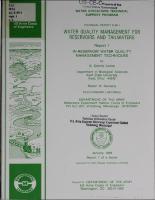Please use this identifier to cite or link to this item:
https://hdl.handle.net/11681/4383| Title: | Water quality management for reservoirs and tailwaters. Report 1, In-reservoir water quality management techniques |
| Authors: | Kent State University. Department of Biological Sciences Water Operations Technical Support Program (U.S.) Environmental and Water Quality Operational Studies (U.S.) Cooke, G. Dennis (George Dennis), 1937- Kennedy, Robert H. |
| Keywords: | Eutrophication Restoration methods Reservoirs Water quality Reservoir management Procedures |
| Publisher: | Environmental Laboratory (U.S.) Engineer Research and Development Center (U.S.) |
| Description: | Technical Report Abstract: Reservoirs are a valuable national resource and provide flood control, water supply, and hydroelectrical, navigational, recreational, and aesthetic benefits. Human influences threaten the quality of this resource, and appropriate protection and enhancement methods must be developed. Of particular concern are the consequences of eutrophication, the process by which lakes and reservoirs are enriched with sediment, organic matter, and plant nutrients. Elevated nutrient concentrations, rooted plant infestations, reduced transparency, excessive algal growth, reduced dissolved oxygen concentrations in bottom waters, and elevated concentrations of organics in finished drinking water are symptoms of this process. Available in-reservoir methods for the management of these eutrophication-related problems are reported here. Also described are methods for problem diagnosis and the selection of appropriate methods. The manual is intended for water quality managers with a variety of scientific and engineering backgrounds. Detailed reference sections provide sources of additional information for each method. NOTE: This file is large. Allow your browser several minutes to download the file. |
| Rights: | Approved for public release; distribution is unlimited. |
| URI: | http://hdl.handle.net/11681/4383 |
| Appears in Collections: | Technical Report |
Files in This Item:
| File | Description | Size | Format | |
|---|---|---|---|---|
| TR-E-89-1-Report-1.pdf | 39.97 MB | Adobe PDF |  View/Open |